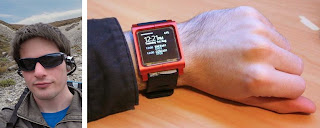Open Source OLED Watch
Last month, we published a blog by Petr Tosovsky highlighting some of the neat open source hardware projects that have been designed in Altium Designer. Most of these have been done by people who have access to Altium Designer as a full commercial package for their day-to-day work as engineers and PCB designers. But there is a thriving next generation of engineers who are doing some pretty awesome work too. We found one such amazing open source project on the blog pages of a 4th-year engineering student at University of Canterbury in New Zealand, Jared Sanson. I asked Jared some questions and to share some of his thoughts on this neat project.
[Ben Jordan] An OLED based smart watch is an impressive thing to design and build solo. Why did you start this project?
[Jared Sanson] I started building this watch project because I had an OLED display lying around, but no way to drive it. After starting to design a breakout PCB in Altium, I realised it was such a waste so I decided to turn it into a smart-watch platform, complete with Bluetooth LE and various sensors.
[Ben Jordan] You’re currently in your final year of Computer Engineering at University of Canterbury in NZ. Was this project helpful in your work there?
[Jared Sanson] It’s taken about a year, and I finally have something that can actually tell the time, as well as being able to keep track of my university timetable. This project was a great way to learn the intricacies of Altium Designer, embedded programming, and hardware debugging (there were some pretty tricky hardware bugs in my design!)
[Ben Jordan] Explain some of your decisions regarding the PCB design and components you chose.
[Jared Sanson] I decided to use a PIC24F microcontroller for this project, which had plenty of processing power to drive the OLED display. I wanted to have the PCB fit the exact dimensions of the OLED to give myself a good design challenge. This posed some restrictions on the types of components I could use, so I tried to stick to 0603 SMD passives and QFN chips where possible. QFN turned out to be fairly easy to solder, but I didn’t have the equipment to solder BGAs so I made sure to avoid those. I also decided to restrict the design to 2 layers in order to keep costs down. This made routing the PCB very tricky indeed. Getting the last few tracks routed on the PCB took as much time as routing most of the PCB!
[Ben Jordan] What were some of the biggest challenges you faced with the board design?
[Jared Sanson] When I was building this I didn’t have access through the university network to the Altium Content Vault, so I had to create a lot of my own library components before I could create the PCB. This taught me a painful lesson when I ordered my first PCB; I forgot to check my footprints against the chips I was using, and the microcontroller footprint turned out to be too small.
[Ben Jordan] I know the pain of a dud prototype board on a student’s wallet all too well! Does anything stand out about Altium Designer which helped make this possible for you?
[Jared Sanson] Altium’s 3D PCB view was extremely helpful when it came to arranging components on the PCB, as it let me see exactly how each component would affect the overall thickness, and how the battery would fit underneath the PCB. I created most of the components using simple 3D primitives such as the buttons and SMD passives, but I also imported STEP models for some of the more complex components such as the USB connector. This allowed me to see exactly how the USB connector would fit onto the PCB.



